Edible Insects Market Size
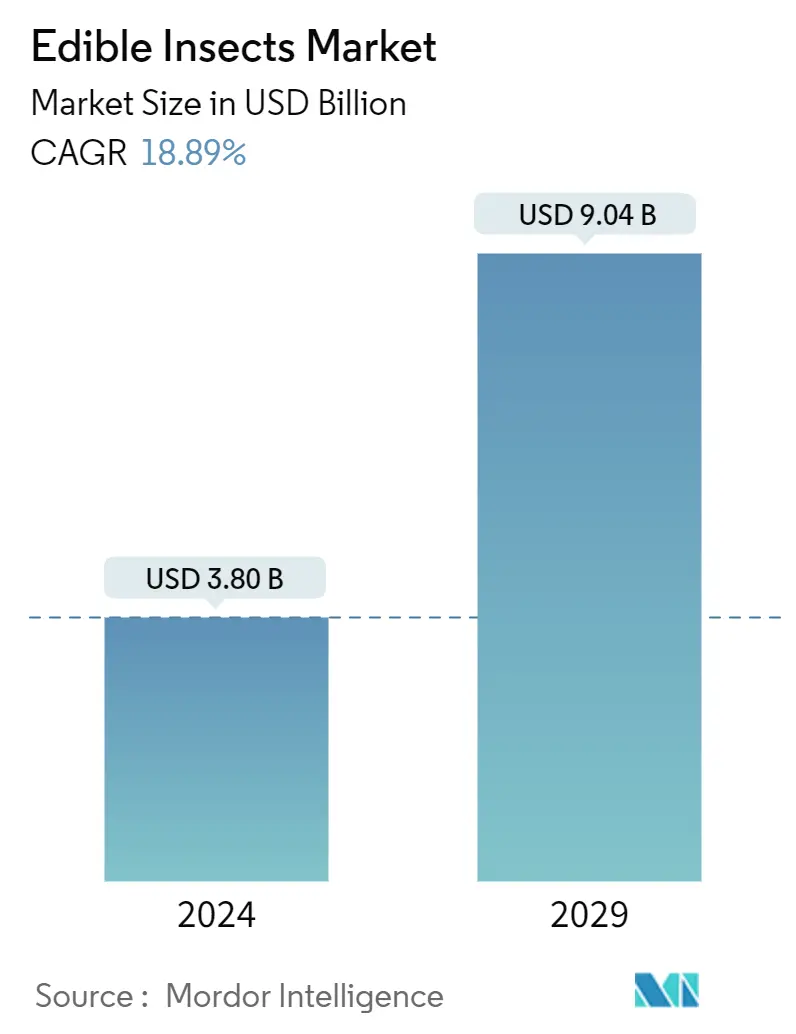
| Study Period | 2019 - 2029 |
| Market Size (2024) | USD 3.80 Billion |
| Market Size (2029) | USD 9.04 Billion |
| CAGR (2024 - 2029) | 18.89 % |
| Fastest Growing Market | Asia-Pacific |
| Largest Market | Europe |
Major Players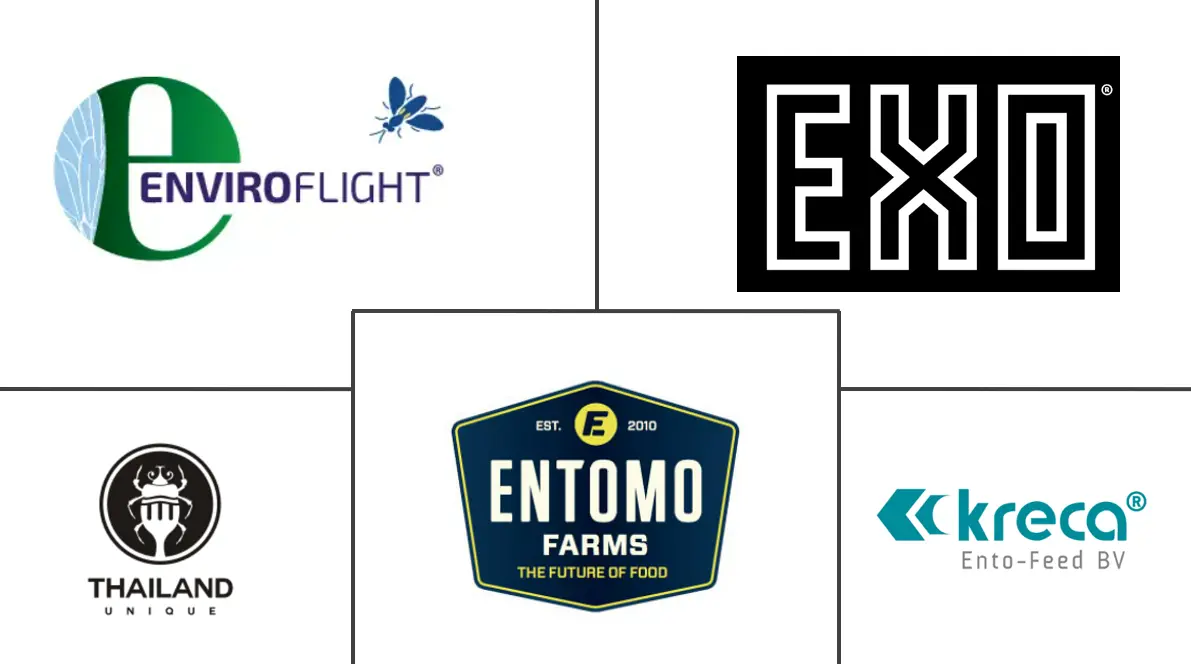
*Disclaimer: Major Players sorted in no particular order |
Need a report that reflects how COVID-19 has impacted this market and its growth?
Edible Insects Market Analysis
The Edible Insects Market size is estimated at USD 3.80 billion in 2024, and is expected to reach USD 9.04 billion by 2029, growing at a CAGR of 18.89% during the forecast period (2024-2029).
- Entotarians (one whose diet includes insects but no other meats) is a novel concept that came into existence as a problem solver to feed the estimated 10 billion people that the world will have in some years. The growing number of entotarians has intensified the demand for edible insects worldwide.
- In addition, due to consumer desire for more sustainable and alternative food and feed products, the use of edible insects has been gradually developing. For instance, according to recent estimates, approximately 2,111 species of insects are consumed in about 140 countries, with entomophagy documented around the world like in Asia, Australia, Africa, and the Americas are already consumed regularly by people and domestic animals across the globe owing to their high protein, healthy fat, mineral, and vitamin content.
- The consumption of insects in the tropical and sub-tropical Asian regions from various insect groups in these regions. Insect-eating habits are not only associated with nutritional aspects but are also closely related to socio-cultural practices and religious beliefs. Edible insects are also used to complement diets with rich protein sources and ecologically sustainable sources of the region's food.
- According to the FAO Edible Insects from a Food Safety Perspective, Report 2021, there are some regulatory frameworks for edible insects in distinct countries to govern the production and commercialization of insects in food and feed supply chains. For instance, in the United States, in the year 2020, the food uses of edible insects, insect parts, or derivatives fall within the oversight of the United States of America Food and Drug Administration (FDA). As such, edible insects and insect-based food products must comply with the Federal Food, Drug, and Cosmetic Act (FD&C Act) and its implementing regulations. For example, if insects and insect derivatives are to be used as food or color additives, these uses must be approved by the FDA.
- Many government associations are developing numerous projects and initiatives to focus on investments, research, and industry partners to escalate the edible insects business globally. For instance, in October 2022, the Australian Centre for International Agricultural Research (ACIAR) collaborated with AgriFutures Australia and the International Centre for Insect Physiology and Ecology (ICIPE) to create a new research hub launched in Australia, which derives the emerging insect technology with industries using insects as human food, animal feed, fertilizer and other products such as oil.
Edible Insects Market Trends
Easy Availability and High Protein Content in The Edible Insects
The accessibility and affordability of edible insects are high in the market. They can be easily cultivated, procured, and incorporated into the daily diet as additives in various forms or as a whole, thereby enhancing the overall nutritional quality of the food. In addition, these insects exhibit minimal processing operations during post-harvest, thus providing a highly economical alternative to animal-based meat products.
Among the edible insects, beetles constitute the largest volume share. Insects are sustainable sources of amino acids and proteins. They are also rich in Omega-3, minerals, dietary fiber, and fatty acids. The insects were also found to be good sources of micronutrients like iron, zinc, magnesium, manganese, phosphorus, and selenium. The vitamin content in edible insects includes riboflavin, pantothenic acid, biotin, and, in some cases, folic acid. Due to multiple nutritional elements, insects are rapidly added to the food and beverage industry. The shifting trend towards sustainable practices will likely push the market in the coming years.
A study conducted by FAO Edible Insects from a Food Safety Perspective Report 2021 stated that 92 percent of known edible insect species are wild-harvested, 6 percent are semi-domesticated, and 2 percent are farmed. Among the known wild-harvested edible insect species, 88 percent are terrestrial, and the remaining are collected from aquatic ecosystems. Recently, some other insect species have been farmed intensively; for instance, the industrialized production of house crickets (Acheta domesticus) in the United States of America mainly for pet food and fishing bait (Morales-Ramos et al., 2020).
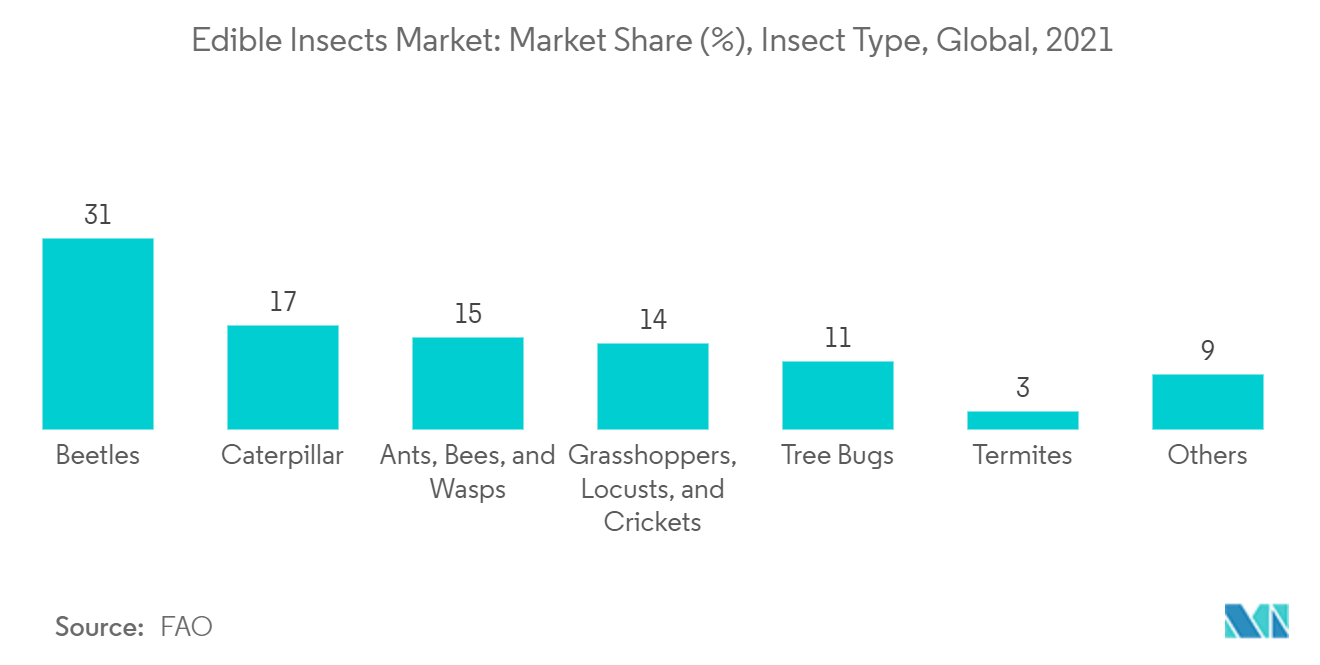
Europe Dominates the Market
Europe continues to dominate the global edible insects market. The growing interest in the edible insect market is due to the growing demand for protein-rich food and the diversification of protein sources consumption in European countries. The edible insect and insect based-food sector has recently increased in the quantities produced and traded owing to awareness-raising actions and the development of European regulations. According to the FAO, insects are part of the diet of more than two billion people around the world. Currently, edible insects represent a niche market in western societies. However, insect farming is a growing industry in Europe as our dietary habits are rapidly changing and the willingness of consumers to try insect-based food is increasing.
In the context of the growing interest in edible insects on the European market, certain national policy attention and prompt regulatory response were generated. In the European Union (EU) whole insects and their ingredients are included under Regulation (EU) No 2015/2283 on novel foods (or the 'new' novel food regulation). The Regulation came into force on 1st January 2018 and requires pre-market authorizations before commercializing these products across the EU market.
Gaining production of insect-based products (whole insects, insect ingredients, and products incorporated with edible insects) placed on the European market, massive investments for the channel in marketing, and increase in consumption is driven by several factors, notably the expected authorization of insects as a novel food, the diversity in products on the market, availability of the product (e.g. availability in retail outlets) and the consumers' acceptance are some of the essential factors boosting the edible insects market during the coming years.
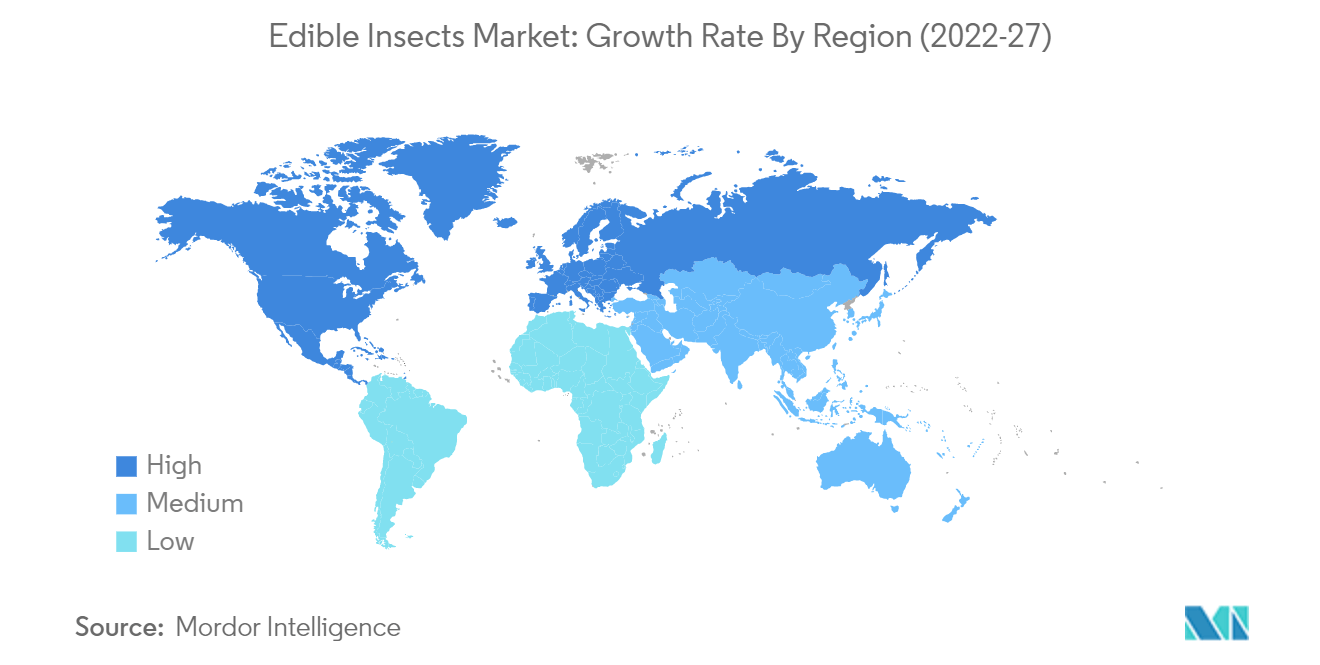
Edible Insects Industry Overview
The edible insects market is highly fragmented, as most companies are new in the market studied and hold only a tiny fraction of the market share, as per the companies profiled in the study. Exo Inc., Thailand Unique, Entomo Farms Ltd., Kreca Ento - Feed BV, and Enviro Flight LLC are some prominent companies that account for a significant share of the edible insect market. Product innovations and new product launches are among the most popular market strategies among the players in the market studied. The significant players primarily focus on investing in R&D and enhancing their production capacities to cope with the ever-increasing demand and stay relevant in the market.
Edible Insects Market Leaders
-
Exo Inc.
-
Thailand Unique
-
Entomo Farms Ltd.
-
Kreca Ento - Feed BV
-
Enviro Flight LLC
*Disclaimer: Major Players sorted in no particular order
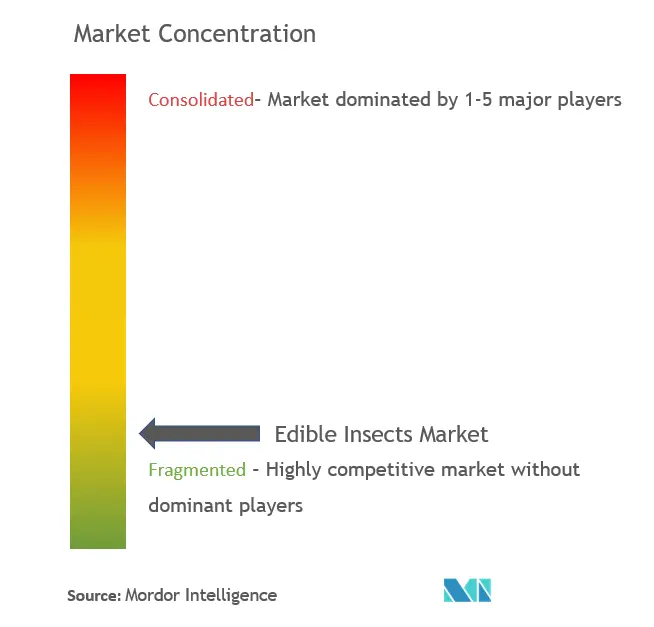
Edible Insects Market News
- September 2022: Lotte Confectionery, a leading South Korean snack and ice cream maker, signed a memorandum of understanding (MOU) with Aspire Food Group, a Canadian firm renowned for its advanced insect agriculture and food technology, to cooperate in areas of protein alternatives and edible insects.
- September 2022: InnovaFeed, a French company, has expanded the edible insect arena with an investment raised of USD 250 million backed by ADM and Cargill by the escalation of the production facility of black farm soldier flies in Decatur, Illinois.
- April 2022: The ValuSect consortium of European insect producers has extended EUR 460,000 (USD 496,600) worth of services to 18 edible insect enterprises. The selected companies will get help from expert partners to develop their innovative idea, which will improve insect production and consumer acceptance in North-West Europe.
Edible Insects Market Report - Table of Contents
1. INTRODUCTION
1.1 Study Assumptions and Market Definition
1.2 Scope of the Study
2. RESEARCH METHODOLOGY
3. EXECUTIVE SUMMARY
4. MARKET DYNAMICS
4.1 Market Overview
4.2 Market Drivers
4.3 Market Restraints
4.4 Porter's Five Forces Analysis
4.4.1 Bargaining Power of Buyers
4.4.2 Bargaining Power of Suppliers
4.4.3 Threat of New Entrants
4.4.4 Threat of Substitute Products
4.4.5 Intensity of Competitive Rivalry
5. MARKET SEGMENTATION
5.1 Insect Type
5.1.1 Beetles
5.1.2 Caterpillar
5.1.3 Hymenoptera
5.1.4 Orthoptera
5.1.5 Tree Bugs
5.1.6 Other Insect Types
5.2 Product Type
5.2.1 As a Whole
5.2.1.1 BBQ
5.2.1.2 Stream or Fried
5.2.1.3 Raw
5.2.2 As a Ingredient
5.2.2.1 Drinks
5.2.2.2 Insect Confectionery
5.2.2.3 Snacks and Backed Products
5.2.2.4 Others
5.3 Geography
5.3.1 North America
5.3.1.1 United States
5.3.1.2 Canada
5.3.1.3 Mexico
5.3.1.4 Rest of North America
5.3.2 Europe
5.3.2.1 Germany
5.3.2.2 United Kingdom
5.3.2.3 France
5.3.2.4 Russia
5.3.2.5 Poland
5.3.2.6 Rest of Europe
5.3.3 Asia-Pacific
5.3.3.1 China
5.3.3.2 Japan
5.3.3.3 Thailand
5.3.3.4 Rest of Asia-Pacific
5.3.4 South America
5.3.4.1 Brazil
5.3.4.2 Argentina
5.3.4.3 Rest of South America
5.3.5 Middle-East & Africa
5.3.5.1 South Africa
5.3.5.2 Rest of Middle-East & Afric
6. COMPETITIVE LANDSCAPE
6.1 Most Adopted Strategies
6.2 Market Share Analysis
6.3 Company Profiles
6.3.1 Thailand Unique
6.3.2 Nordic Insect Economy Ltd.
6.3.3 Kreca Ento - Feed BV
6.3.4 Entomo Farms Ltd.
6.3.5 Exo Inc.
6.3.6 Proti - Farm
6.3.7 Enviro Flight LLC
6.3.8 Bugsy Bros
6.3.9 Deli Bugs Ltd.
6.3.10 Eat Grub Ltd
7. MARKET OPPORTUNITITES AND FUTURE TRENDS
Edible Insects Industry Segmentation
Insects as food or edible insects are insect species used for human consumption. More than 2,000 insect species worldwide are considered edible. Common forms of consumption are whole insects on one hand and pulverized insects used as an ingredient in dishes or in terms of processed food products such as burger patties, pasta, snacks, and many others. The Edible Insects Market is segmented by Insect Type into Beetles, Caterpillars, Hymenoptera, Orthoptera, Tree Bugs, and Other Insect Types, Product Type As A Whole, and As Ingredient, and Geography into North America, Europe, Asia-Pacific, South America, Middle-East & Africa. The report offers the market size and forecasts in terms of value in (USD Thousands) for all the above segments.
| Insect Type | |
| Beetles | |
| Caterpillar | |
| Hymenoptera | |
| Orthoptera | |
| Tree Bugs | |
| Other Insect Types |
| Product Type | ||||||
| ||||||
|
| Geography | ||||||||
| ||||||||
| ||||||||
| ||||||||
| ||||||||
|
Edible Insects Market Research FAQs
How big is the Edible Insects Market?
The Edible Insects Market size is expected to reach USD 3.80 billion in 2024 and grow at a CAGR of 18.89% to reach USD 9.04 billion by 2029.
What is the current Edible Insects Market size?
In 2024, the Edible Insects Market size is expected to reach USD 3.80 billion.
Who are the key players in Edible Insects Market?
Exo Inc., Thailand Unique, Entomo Farms Ltd., Kreca Ento - Feed BV and Enviro Flight LLC are the major companies operating in the Edible Insects Market.
Which is the fastest growing region in Edible Insects Market?
Asia-Pacific is estimated to grow at the highest CAGR over the forecast period (2024-2029).
Which region has the biggest share in Edible Insects Market?
In 2024, the Europe accounts for the largest market share in Edible Insects Market.
What years does this Edible Insects Market cover, and what was the market size in 2023?
In 2023, the Edible Insects Market size was estimated at USD 3.08 billion. The report covers the Edible Insects Market historical market size for years: 2019, 2020, 2021, 2022 and 2023. The report also forecasts the Edible Insects Market size for years: 2024, 2025, 2026, 2027, 2028 and 2029.
What emerging technologies are impacting the Edible Insects Industry?
The emerging technologies impacting the Edible Insects Industry are a) Vertical farming b) Automation in insect production c) Advancements in processing and preservation
Edible Insects Industry Report
The global edible insects market is witnessing remarkable growth due to heightened consumer awareness about the environmental impacts of traditional livestock farming, propelling a shift towards edible insects as a sustainable protein source. This trend is bolstered by the nutritional benefits of insects, such as high protein, fiber, and essential nutrients, fitting well into diets like keto and paleo. Innovations in food products that incorporate edible insects, including protein bars, pasta, and snacks, meet the rising demand for alternative proteins and culinary adventures. Despite facing cultural aversions, technological limits, and regulatory variances, industry players are advancing through strategic partnerships and product innovations to mainstream insect consumption and broaden market presence. Edible insects, particularly grasshoppers for their nutritional and culinary versatility, are segmented by product, application, and distribution, signaling substantial growth potential. Statistics for the Edible Insects market share, size and revenue growth rate, created by Mordor Intelligence™ Industry Reports. Edible Insects analysis includes a market forecast outlook and historical overview. Get a sample of this industry analysis as a free report PDF download.

